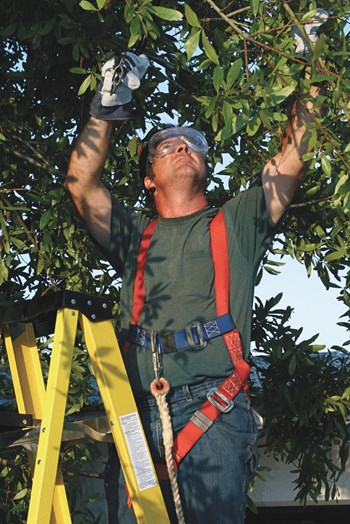
Trees and other green landscaping elements are some of your association's most valuable assets. In addition to providing all-important curb appeal, trees and shrubs provide privacy, act as windscreens, and prevent soil erosion. Taking care of your trees and other large plants is just as important as caring for your paved surfaces, roofing, or any other exterior element.
Drought/Cold Kills
The impact of winter’s adverse weather on the health and survival of plants is difficult to predict. The current extreme drought conditions in New Jersey, combined with two very severe winters have presented a worst-possible-case scenario for all natural vegetation, and put enormous stress on suburban trees.
Trees struggling against root restriction, poor drainage and the subpar soil conditions that exist in many communities are particularly hard-hit. Frozen ground has inhibited the intake of water through roots, while at the same time, icy winds have accelerated the process of water loss (or “transpiration”) through leaves and stems resulting in a condition known as winterkill. The trees’ weakened condition is an open invitation to attracting rot, fungi, and a variety of insects. The degree of plant injury above and below ground may not be readily apparent, but the effects may be felt long into the future. Come springtime, many of your community trees will experience much slower growth while they rebuild their defenses.
Trees and shrubs that have suffered will definitely benefit from special care, including watering and maintaining adequate soil moisture, proper mulching, careful pruning, bio-fertilization and applications of Cambistat—a treatment that reduces canopy growth and redirects that energy to other parts of the tree's system, such as roots, defense and storage. A good root system is necessary for overcoming drought and winter stress, and early bio-fertilization will help encourage root growth and give your trees and shrubs a head start.
Early Preventive Maintenance
Trees and shrubs sleep in winter—and so do parasites. The early application of horticultural oil is safe for the environment and prevents over-wintering pests from attacking your trees and shrubs later in the season. The application of horticultural oil on woody plants to control a large variety of pests is not a new practice, but is one that has not been widely used until recently. In response to increasing public demand to reduce chemical pesticide use, refined horticultural oils provide a safer and more environmentally friendly method of pest management. They degrade quickly following application, are non-toxic to humans and wildlife and fit very nicely into a Plant Health Care (PHC) program.
In the interest of reducing negative environmental impact while at the same time insuring the preservation of your landscape's trees and shrubs, the professional tree care industry has developed the PHC system, which enables professional practitioners to monitor your landscape plants on a regular basis and select the most environmentally sound and economically viable methods for maintaining plant vigor while controlling insects and diseases. PHC employs principles of Integrated Pest Management (IPM), using fewer pesticides and increasing inspection and monitoring visits during the growing season. The number of visits is personalized for your community, based on the trees and shrubs in your landscape.
No-Spray, No-Salt Solutions
The key tactics in a PHC program are new and environmentally-responsible tree health and beauty treatments based on soil injection systems as an alternative to spraying chemicals. This technology utilizes the tree’s vascular system for transporting nutrients and pesticide uniformly to all parts of the plant in very low, scientifically-determined dosage rates. PHC treatments cover a broad spectrum and have long residual activity, which reduces the need for repeat applications. Since the treatments make use of the tree's closed system, they cannot blow or wash away—virtually eliminating the possibility of environmental contamination, and making them invulnerable to wind and rain.
Along with harsh chemicals and pesticides, another perennial threat to landscape plants is salt. Preventing salt damage is a year round battle. During winter, avoid piling snow containing salt around trees or where runoff will flow over plant root zones. Where salt exposure is unavoidable, you can reduce the damage by simply rinsing the salt off. Flush the area around trees and shrubs in early spring by applying two inches of water over a two- to three-hour period, repeating this procedure three days later.
During summer, work to improve plant conditions. Incorporate large quantities of organic material into salt-damaged soil to enhance its texture and increase its water and nutrient holding capacity. Plants that are already stressed by salt will do much better if no other stresses are added to them, so be sure this spring to have your trees and shrubs properly bio-fertilized with a good organic root stimulant. When selecting species for new plantings that may be injured by salt runoff, consider salt-tolerant species such as White Oak, Honey Locust, Norway Maple, Scotch Pine, Red Oak or Juniper. Avoid salt sensitive species such as White Pine, Red Maple and Sugar Maple. A low wall or hedge of salt tolerant evergreens can also deflect salt spray from sensitive trees nearby.
When in Doubt
When your building or association is due for new siding, or the common sidewalks are beginning to show their age, it's easy to tell—paint peels, cracks appear, and people notice. Landscaping elements like trees and shrubs are often harder to read. Sometimes trouble doesn't appear in the form of brown leaves or missing spring foliage until a season or two after the damage was done. This is why it's vital for association administrators to work closely with their chosen landscaping professionals to make sure that their community's trees and shrubs properly cared for and maintained. With a solid PHC program in effect, your community's valuable living assets will remain healthy and green for generations.
Sam deTuro is chairman of Woodwinds Associates, Inc., a tree care and landscaping firm based in Princeton.






Leave a Comment